Abstract
Biological monitoring of exposure of workers to polycyclic aromatic hydrocarbons (PAHs) in petrochemical industries was performed by the measurement of urinary excretion of 1-hydroxypyrene. In 121 of the 462 workers studied (both smokers and non-smokers) who had had no recent occupational exposure to PAHs a median 1-hydroxypyrene concentration of 0.21 micrograms/g creatinine was found. The upper limit of the 95% confidence interval in these workers of 0.99 micrograms/g creatinine was used as the upper normal value for industrial workers. Urinary 1-hydroxypyrene concentrations were measured in workers involved in manufacture and maintenance operations in oil refineries (13 studies in eight different settings), in workers manufacturing or handling products containing PAHs in chemical plants (five studies in three settings) and laboratories (four studies), and in workers digging soil contaminated with PAHs (three studies). In most studies in oil refineries 1-hydroxypyrene concentrations were only marginally greater than the values measured in the 121 workers with no recent occupational exposure to PAHs. This was also the case in maintenance operations with higher potential exposure to PAHs, indicating that personal protection equipment was generally adequate to prevent excessive exposure. The studies in chemical plants also showed that exposure to PAHs is low. An exception was the workers engaged in the production of needle coke from ethylene cracker residue, where increased urinary 1-hydroxypyrene concentrations were measured. The excretion of 1-hydroxypyrene by the operators and maintenance workers of this plant was investigated in relation to potential methods of exposure to PAHs. Dermal and inhalatory exposure were both significant determinants of exposure to PAHs.
Full text
PDF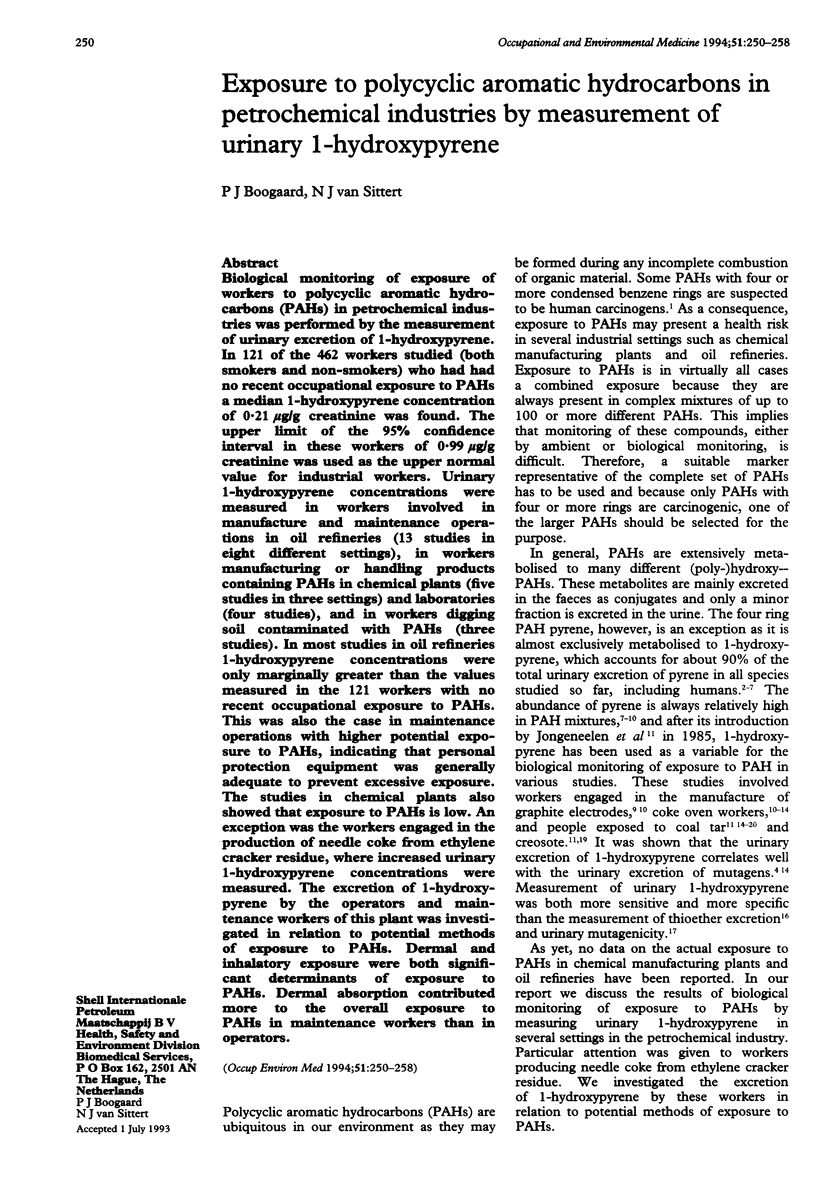
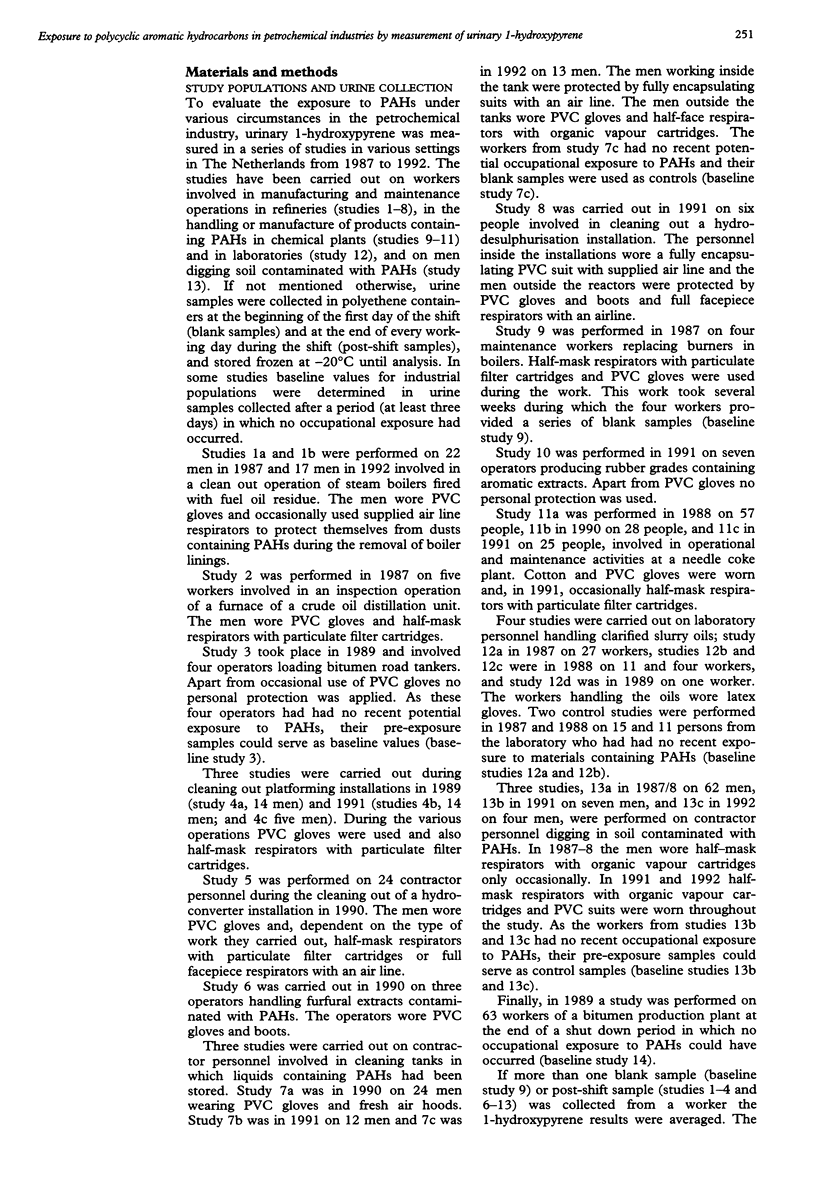
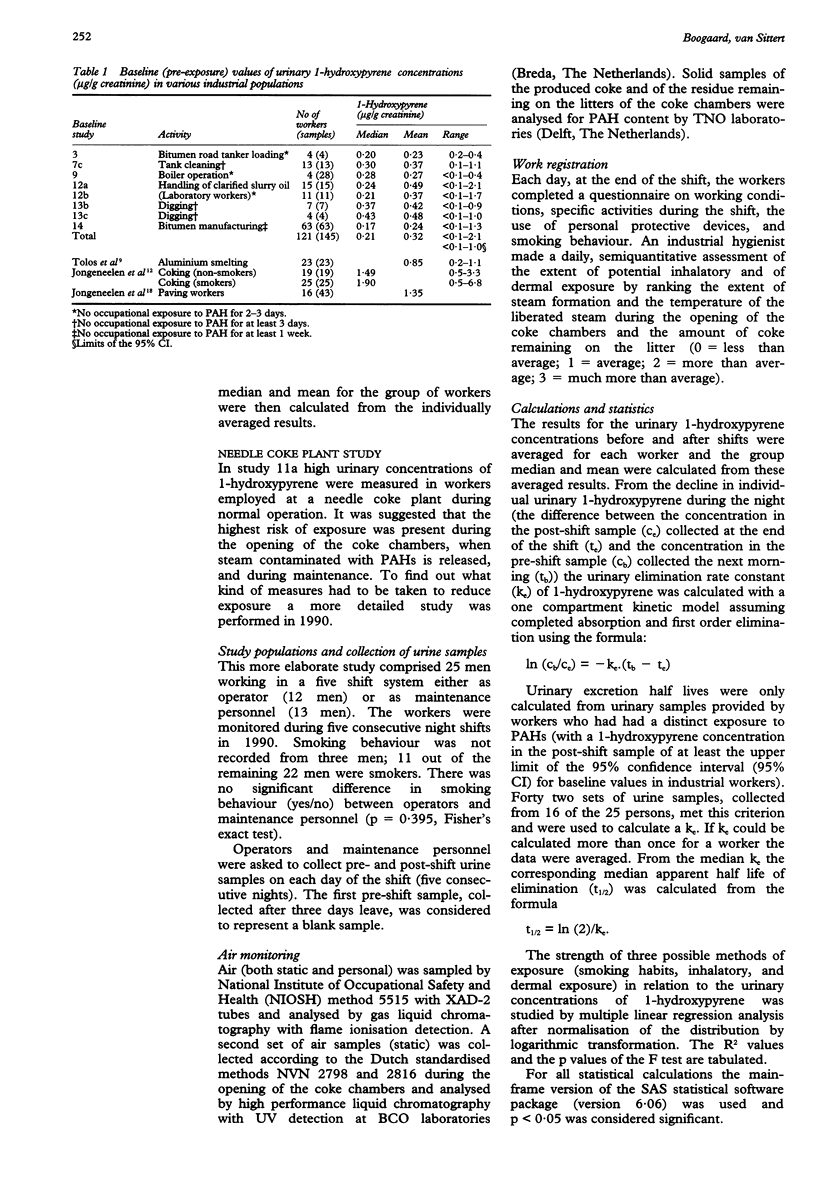
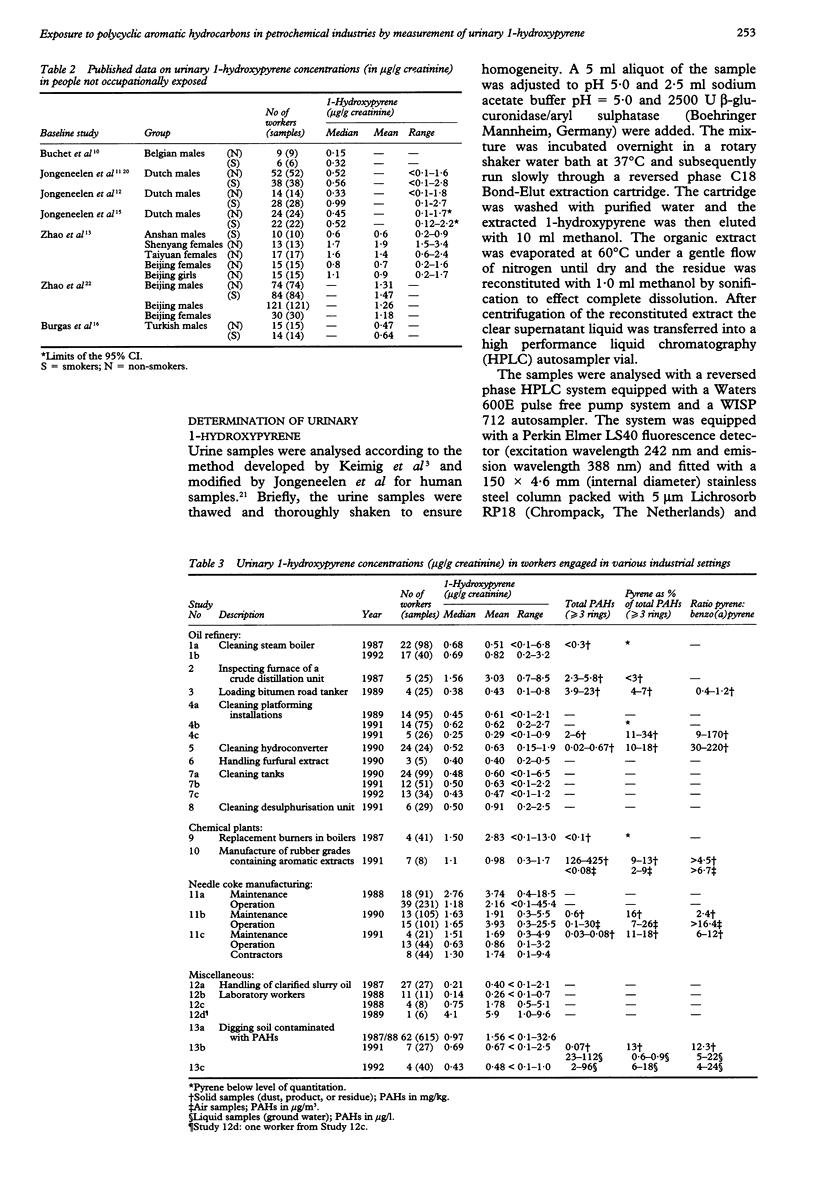
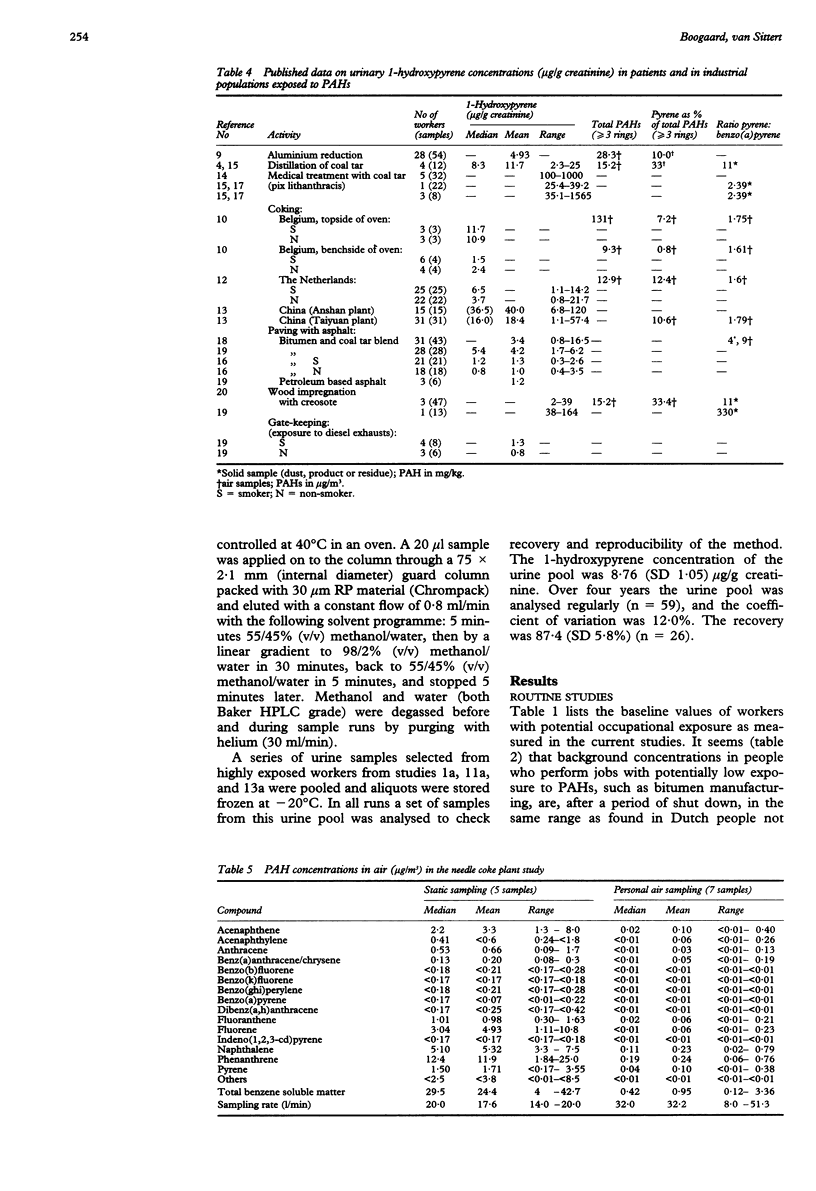
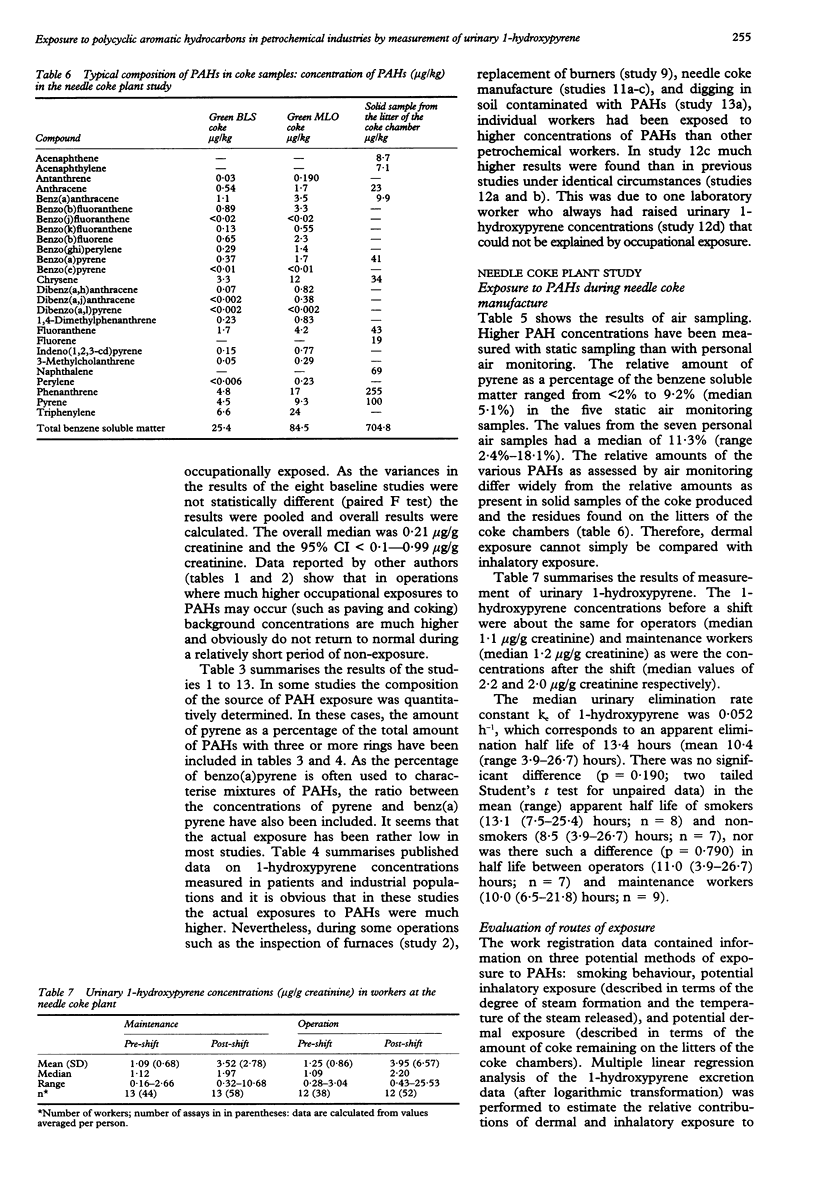
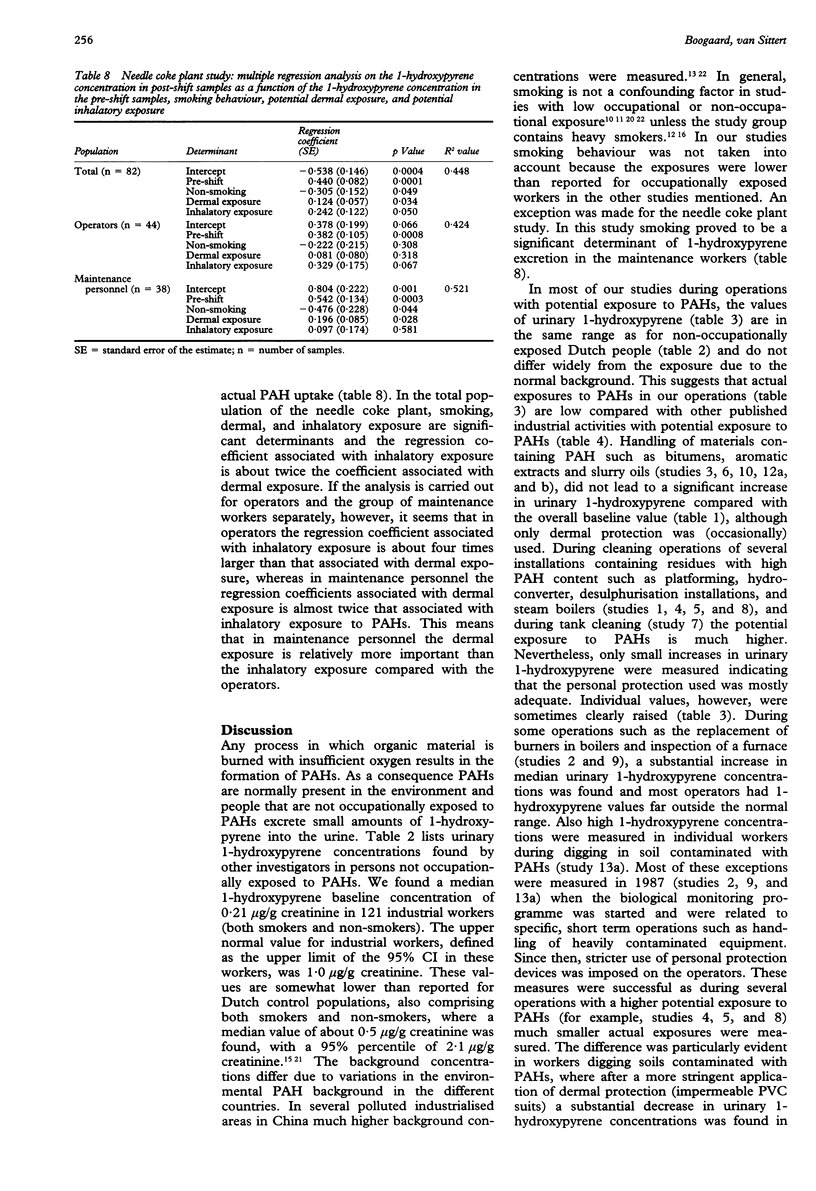
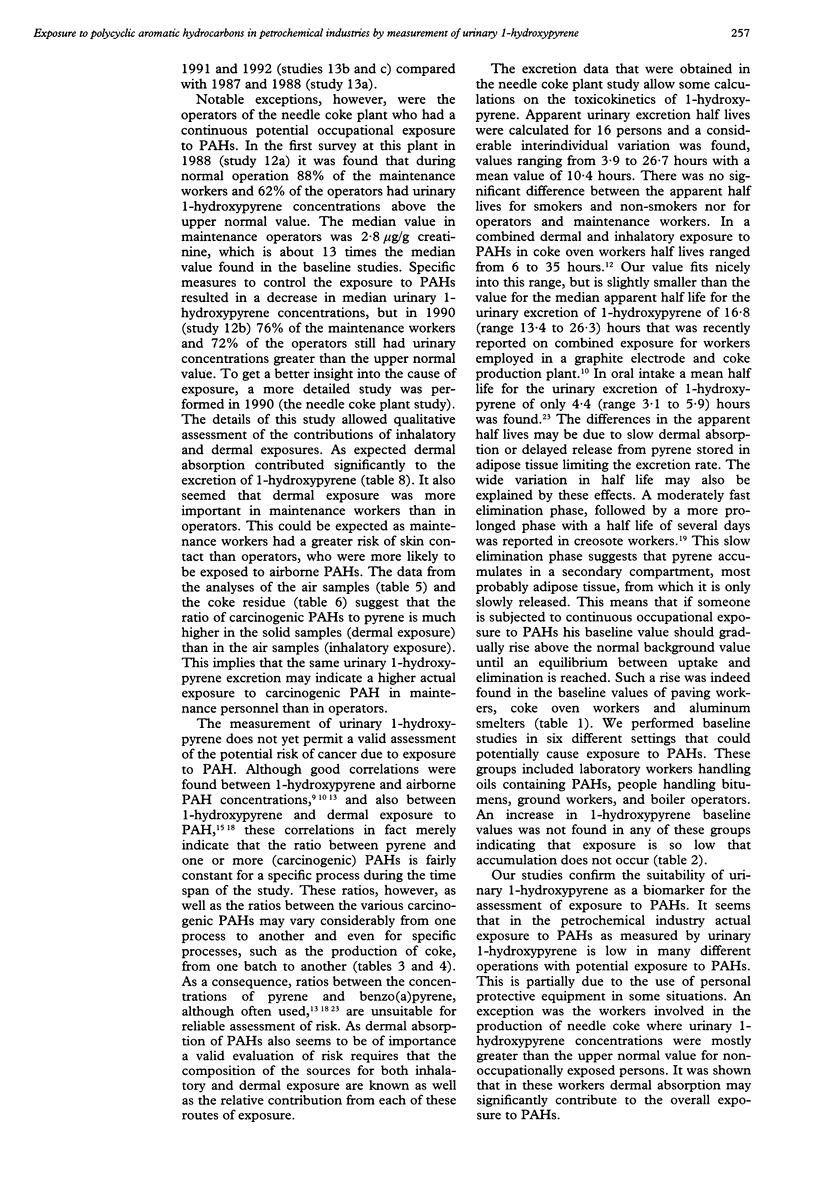
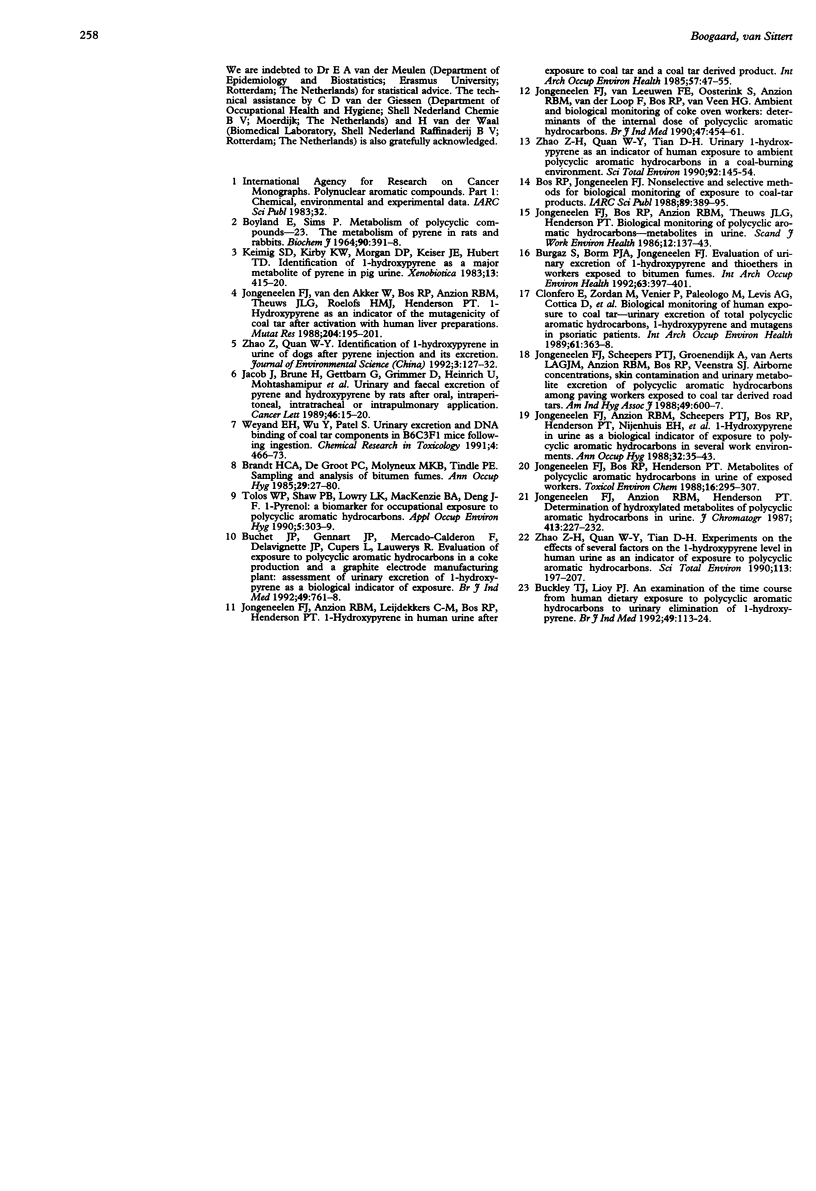
Selected References
These references are in PubMed. This may not be the complete list of references from this article.
- Bos R. P., Jongeneelen F. J. Nonselective and selective methods for biological monitoring of exposure to coal-tar products. IARC Sci Publ. 1988;(89):389–395. [PubMed] [Google Scholar]
- Boyland E., Sims P. Metabolism of polycyclic compounds. 23. The metabolism of pyrene in rats and rabbits. Biochem J. 1964 Feb;90(2):391–398. doi: 10.1042/bj0900391. [DOI] [PMC free article] [PubMed] [Google Scholar]
- Brandt H. C., de Groot P. C., Molyneux M. K., Tindle P. E. Sampling and analysis of bitumen fumes. Ann Occup Hyg. 1985;29(1):27–80. doi: 10.1093/annhyg/29.1.27. [DOI] [PubMed] [Google Scholar]
- Buchet J. P., Gennart J. P., Mercado-Calderon F., Delavignette J. P., Cupers L., Lauwerys R. Evaluation of exposure to polycyclic aromatic hydrocarbons in a coke production and a graphite electrode manufacturing plant: assessment of urinary excretion of 1-hydroxypyrene as a biological indicator of exposure. Br J Ind Med. 1992 Nov;49(11):761–768. doi: 10.1136/oem.49.11.761. [DOI] [PMC free article] [PubMed] [Google Scholar]
- Buckley T. J., Lioy P. J. An examination of the time course from human dietary exposure to polycyclic aromatic hydrocarbons to urinary elimination of 1-hydroxypyrene. Br J Ind Med. 1992 Feb;49(2):113–124. doi: 10.1136/oem.49.2.113. [DOI] [PMC free article] [PubMed] [Google Scholar]
- Burgaz S., Borm P. J., Jongeneelen F. J. Evaluation of urinary excretion of 1-hydroxypyrene and thioethers in workers exposed to bitumen fumes. Int Arch Occup Environ Health. 1992;63(6):397–401. doi: 10.1007/BF00386935. [DOI] [PubMed] [Google Scholar]
- Clonfero E., Zordan M., Venier P., Paleologo M., Levis A. G., Cottica D., Pozzoli L., Jongeneelen F. J., Bos R. P., Anzion R. B. Biological monitoring of human exposure to coal tar. Urinary excretion of total polycyclic aromatic hydrocarbons, 1-hydroxypyrene and mutagens in psoriatic patients. Int Arch Occup Environ Health. 1989;61(6):363–368. doi: 10.1007/BF00381025. [DOI] [PubMed] [Google Scholar]
- Jacob J., Brune H., Gettbarn G., Grimmer D., Heinrich U., Mohtashamipur E., Norpoth K., Pott F., Wenzel-Hartung R. Urinary and faecal excretion of pyrene and hydroxypyrene by rats after oral, intraperitoneal, intratracheal or intrapulmonary application. Cancer Lett. 1989 Jul 1;46(1):15–20. doi: 10.1016/0304-3835(89)90209-7. [DOI] [PubMed] [Google Scholar]
- Jongeneelen F. J., Anzion R. B., Henderson P. T. Determination of hydroxylated metabolites of polycyclic aromatic hydrocarbons in urine. J Chromatogr. 1987 Jan 23;413:227–232. doi: 10.1016/0378-4347(87)80230-x. [DOI] [PubMed] [Google Scholar]
- Jongeneelen F. J., Anzion R. B., Leijdekkers C. M., Bos R. P., Henderson P. T. 1-hydroxypyrene in human urine after exposure to coal tar and a coal tar derived product. Int Arch Occup Environ Health. 1985;57(1):47–55. doi: 10.1007/BF00383545. [DOI] [PubMed] [Google Scholar]
- Jongeneelen F. J., Anzion R. B., Scheepers P. T., Bos R. P., Henderson P. T., Nijenhuis E. H., Veenstra S. J., Brouns R. M., Winkes A. 1-Hydroxypyrene in urine as a biological indicator of exposure to polycyclic aromatic hydrocarbons in several work environments. Ann Occup Hyg. 1988;32(1):35–43. doi: 10.1093/annhyg/32.1.35. [DOI] [PubMed] [Google Scholar]
- Jongeneelen F. J., Bos R. P., Anzion R. B., Theuws J. L., Henderson P. T. Biological monitoring of polycyclic aromatic hydrocarbons. Metabolites in urine. Scand J Work Environ Health. 1986 Apr;12(2):137–143. doi: 10.5271/sjweh.2166. [DOI] [PubMed] [Google Scholar]
- Jongeneelen F. J., Scheepers P. T., Groenendijk A., Van Aerts L. A., Anzion R. B., Bos R. P., Veenstra S. J. Airborne concentrations, skin contamination, and urinary metabolite excretion of polycyclic aromatic hydrocarbons among paving workers exposed to coal tar derived road tars. Am Ind Hyg Assoc J. 1988 Dec;49(12):600–607. doi: 10.1080/15298668891380312. [DOI] [PubMed] [Google Scholar]
- Jongeneelen F. J., van Leeuwen F. E., Oosterink S., Anzion R. B., van der Loop F., Bos R. P., van Veen H. G. Ambient and biological monitoring of cokeoven workers: determinants of the internal dose of polycyclic aromatic hydrocarbons. Br J Ind Med. 1990 Jul;47(7):454–461. doi: 10.1136/oem.47.7.454. [DOI] [PMC free article] [PubMed] [Google Scholar]
- Jongeneelen F. J., vd Akker W., Bos R. P., Anzion R. B., Theuws J. L., Roelofs H. M., Henderson P. T. 1-Hydroxypyrene as an indicator of the mutagenicity of coal tar after activation with human liver preparations. Mutat Res. 1988 Feb;204(2):195–201. doi: 10.1016/0165-1218(88)90089-4. [DOI] [PubMed] [Google Scholar]
- Keimig S. D., Kirby K. W., Morgan D. P., Keiser J. E., Hubert T. D. Identification of 1-hydroxypyrene as a major metabolite of pyrene in pig urine. Xenobiotica. 1983 Jul;13(7):415–420. doi: 10.3109/00498258309052279. [DOI] [PubMed] [Google Scholar]
- Weyand E. H., Wu Y., Patel S., Taylor B. B., Mauro D. M. Urinary excretion and DNA binding of coal tar components in B6C3F1 mice following ingestion. Chem Res Toxicol. 1991 Jul-Aug;4(4):466–473. doi: 10.1021/tx00022a011. [DOI] [PubMed] [Google Scholar]
- Zhao Z. H., Quan W. Y., Tian D. H. Experiments on the effects of several factors on the 1-hydroxypyrene level in human urine as an indicator of exposure to polycyclic aromatic hydrocarbons. Sci Total Environ. 1992 Mar 31;113(3):197–207. doi: 10.1016/0048-9697(92)90001-9. [DOI] [PubMed] [Google Scholar]
- Zhao Z. H., Quan W. Y., Tian D. H. Urinary 1-hydroxypyrene as an indicator of human exposure to ambient polycyclic aromatic hydrocarbons in a coal-burning environment. Sci Total Environ. 1990 Mar;92:145–154. doi: 10.1016/0048-9697(90)90326-p. [DOI] [PubMed] [Google Scholar]


